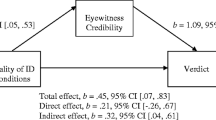Abstract
A mock-jury study was conducted to examine juror sensitivity to eyewitness identification evidence. Subjects were 129 eligible and experienced jurors from Dane County, Wisconsin, who viewed a videotaped trial that involved an eyewitness identification. Ten factors associated with the crime and the identification (e.g., disguise of the perpetrator, retention interval, confidence of the witness) were manipulated. The results of this mock-jury study were combined with those of a previous study using the same experimental stimuli and procedures, but using undergraduates as subjects. This analysis showed that the confidence of the eyewitness was the most powerful predictor of verdicts (p<.05) and that differences between undergraduates and eligible jurors in their sensitivity to eyewitness evidence were negligible.
Similar content being viewed by others
References
Bothwell, R. K., Deffenbacher, K. A., & Brigham, J. C. (1987). Correlation of eyewitness accuracy and confidence: Optimality hypothesis revised.Journal of Applied Psychology, 72, 691–695.
Cutler, B. L., Penrod, S. D., & Dexter, H. R. (1989). The eyewitness, the expert psychologist, and the jury.Law and Human Behavior, 13, 311–332.
Cutler, B. L., Penrod, S. D., & Martens, T. K. (1987). The reliability of eyewitness identifications: The role of system and estimator variables.Law and Human Behavior, 11, 223–258.
Cutler, B. L., Penrod, S. D., & Stuve, T. E. (1988). Juror decisionmaking in eyewitness identification cases.Law and Human Behavior, 12, 41–55.
Fox, S. G., & Walters, H. A. (1986). The impact of general versus specific expert testimony and eyewitness confidence upon mock juror judgment.Law and Human Behavior, 10, 215–228.
Konecni, V. J., & Ebbesen, E. B. (1979). External validity of research in legal psychology.Law and Human Behavior, 3, 39–70.
Lindsay, R. C. L., Lim, R., Marando, L., & Cully, D. (1986). Mock-juror evaluations of eyewitness testimony: A test of metamemory hypotheses.Journal of Applied Social Psychology, 16, 447–459.
Lindsay, R. C. L., Wells, G. L., & Rumpel, C. M. (1981). Can people detect eyewitness identification accuracy within and across situations?Journal of Applied Psychology, 66 79–89.
Malpass, R. S., & Devine, P. G. (1983). Measuring the fairness of eyewitness identification lineups. In S. M. A. Lloyd-Bostock & B. R. Clifford (Eds.),Evaluating witness evidence (pp. 81–102). Chichester, Great Britain: Wiley.
Sears, D. O. (1896). College sophomores in the laboratory: Influences of a narrow data base on social psychology's view of human nature.Journal of Personality and Social Psychology, 51, 515–530.
Walters, C. M. (1985). Admission of expert testimony on eyewitness identification.California Law Review, 73, 1402–1430.
Weiten, W., & Diamond, S. S. (1979). A critical review of the jury simulation paradigm: The case of defendant characteristics.Law and Human Behavior, 3, 71–93.
Wells, G. L., Ferguson, T. J., & Lindsay, R. C. L. (1981). The tractability of eyewitness confidence and its implications for triers of fact.Journal of Applied Psychology, 66, 688–696.
Wells, G. L., & Leippe, M. R. (1981). How do triers of fact infer the accuracy of eyewitness identifications? Using memory for peripheral detail can be misleading.Journal of Applied Psychology, 66, 682–687.
Wells, G. L., Lindsay, R. C. L., & Ferguson, T. J. (1979). Accuracy, confidence, and juror perceptions in eyewitness identification.Journal of Applied Psychology, 64, 440–444.
Wells, G. L., Lindsay, R. C. L., & Tousignant, J. P. (1980). Effects of expert psychological advice on human performance in judging the validity of eyewitness testimony.Law and Human Behavior, 4, 275–285.
Whitley, B. E. Jr., & Greenberg, M. S. (1986). The role of eyewitness confidence in juror perceptions of credibility.Journal of Applied Social Psychology, 16, 387–409.
Author information
Authors and Affiliations
Additional information
This research was funded by the National Science Foundation under grant No. SES-8411721 and the National Institute of Justice under grant No. 84-IJ-CX-0010 to Steven Penrod. Carol Krafka and Peter Shapiro were instrumental in the planning of this research. In addition, we wish to thank Bridgett Bleisner, Michael Bradley, Robert Bull, James Coward, and Thomas Stuve for their assistance with various phases of this research.
About this article
Cite this article
Cutler, B.L., Penrod, S.D. & Dexter, H.R. Juror sensitivity to eyewitness identification evidence. Law Hum Behav 14, 185–191 (1990). https://doi.org/10.1007/BF01062972
Issue Date:
DOI: https://doi.org/10.1007/BF01062972




